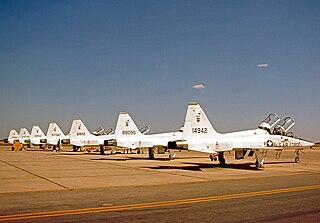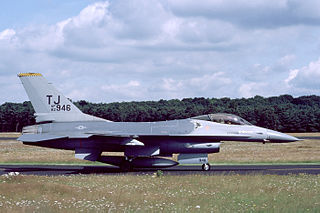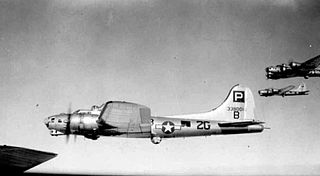
The 561st Weapons Squadron is a United States Air Force squadron assigned to the USAF Weapons School at Nellis Air Force Base, Nevada. The squadron was the last United States Air Force unit to fly the McDonnell F-4 Phantom II on operational missions. The last Republic F-105 Thunderchief shot down in the Vietnam War was from the 561st.

The 706th Aggressor Squadron is part of the 926th Wing at Nellis Air Force Base, Nevada where it oversees Air Force Reserve Command fighter pilots supporting the United States Air Force Warfare Center as an associate of the 57th Wing. Pilots assigned to the 706th fly General Dynamics F-16 Fighting Falcon aircraft.

The 55th Air Refueling Squadron is an inactive United States Air Force unit. It formerly operated both the combat crew training school and central flight instructor course for Boeing KC-135 Stratotanker at Altus Air Force Base, Oklahoma.

The 560th Flying Training Squadron is part of the 12th Flying Training Wing of the United States Air Force based at Randolph Air Force Base, Texas. It operates the Northrop T-38 Talon.

The 446th Operations Group is a United States Air Force Reserve unit assigned to the 446th Airlift Wing. It is stationed at McChord Air Force Base, Washington.

The 703d Tactical Air Support Squadron is an inactive United States Air Force unit. It was last assigned to the 507th Tactical Air Control Wing at Shaw Air Force Base, South Carolina, where it was inactivated in June 1988.

The 615th Tactical Fighter Squadron is an inactive United States Air Force unit. It was last assigned to the 35th Tactical Fighter Wing at Phan Rang Air Base, South Vietnam, where it was inactivated on 15 July 1971.

The 614th Tactical Fighter Squadron is an inactive United States Air Force unit. It was last assigned to the 401st Operations Group at Torrejon Air Base, Spain, where it was inactivated on 1 January 1992.

The 613th Tactical Fighter Squadron is an inactive United States Air Force unit. It was last assigned to the 401st Tactical Fighter Wing, stationed at Torrejon Air Base, Spain, where it was inactivated on 28 June 1991.

The 708th Bombardment Squadron is an inactive United States Air Force unit. It was last assigned to the 447th Bombardment Group at Castle Air Force Base, California, where it was inactivated on 16 June 1951.

The 352d Bombardment Squadron is an inactive United States Air Force unit. It was last assigned to the 301st Bombardment Wing at Lockbourne Air Force Base, Ohio, where it was inactivated on 8 June 1964.

The 781st Bombardment Squadron is an inactive United States Air Force unit. Its last assignment was to the 465th Bombardment Wing, stationed at Robins Air Force Base, Georgia. It was inactivated on 25 July 1968.

The 833rd Bombardment Squadron is an inactive United States Army Air Forces unit. It trained as a Consolidated B-24 Liberator unit, and deployed with its planes to the European Theater of Operations, entering combat in the strategic bombing campaign against Germany on 7 May 1944. In July 1944, the squadron converted to Boeing B-17 Flying Fortresses, continuing combat with the 486th Bombardment Group until April 1945. Following V-E Day it returned to Drew Field, Florida, where it was inactivated on 7 November 1945.

The 347th Bombardment Squadron is an inactive United States Air Force unit. It was last assigned to the 4047th Strategic Wing, and was inactivated at McCoy Air Force Base, Florida on 1 April 1963.

The 743d Bombardment Squadron was first activated in June 1943. After training in the United States with the Consolidated B-24 Liberator bombers, the 743d deployed to the Mediterranean Theater of Operations, participating in the strategic bombing campaign against Germany. It earned two Distinguished Unit Citations for its combat operations. Following V-E Day, it remained in Italy without its flight echelon until inactivating in September 1945

The 534th Training Squadron is an inactive United States Air Force unit. It was last assigned to the 381st Training Group at Vandenberg Air Force Base, California, where it conducted qualification training for airmen in satellite control operations and maintenance.

The 836th Bombardment Squadron was a United States Army Air Forces unit. It was activated in September 1943. After training in the United States, it deployed to the European Theater of Operations, where it engaged in combat in the strategic bombing campaign against Germany with Consolidated B-24 Liberators. In the summer of 1944, it was withdrawn from combat to convert to the Boeing B-17 Flying Fortress, then continued in combat with the 487th Bombardment Group until the spring of 1945. Following V-E Day, the squadron returned to Drew Field, Florida, where it was inactivated on 7 November 1945.

The 837th Bombardment Squadron was a United States Army Air Forces unit. It was activated in September 1943. After training in the United States, it deployed to the European Theater of Operations, where it engaged in combat with Consolidated B-24 Liberators. In the summer of 1944, it was withdrawn from combat to convert to the Boeing B-17 Flying Fortress, then continued in the strategic bombing campaign against Germany with the 487th Bombardment Group until the spring of 1945. Following V-E Day, the squadron returned to Drew Field, Florida, where it was inactivated on 7 November 1945.

The 704th Fighter Squadron is an inactive United States Air Force unit. It was last assigned to the 924th Fighter Group at Bergstrom Air Force Base, Texas, where it was inactivated on 27 September 1996, when Air Force operations at Bergstrom ended.

The 705th Tactical Airlift Training Squadron is an inactive United States Air Force unit. It was last assigned to the 924th Tactical Airlift Group at Ellington Air Force Base, Texas where it was inactivated on 30 June 1976, when reserve flying operations at Ellington ended.























